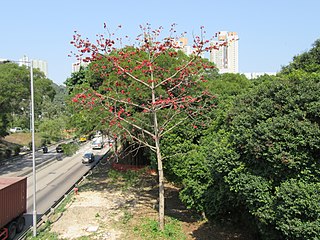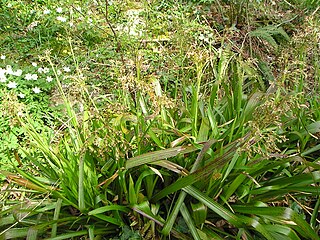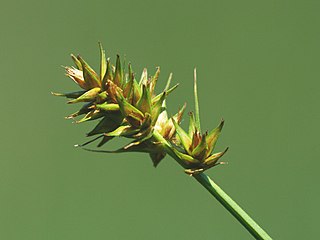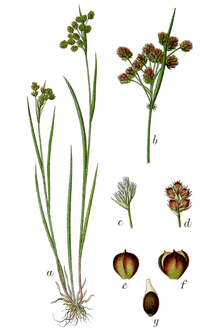
Liquidambar, commonly called sweetgum (star gum in the UK), gum, redgum, satin-walnut, or American storax, is the only genus in the flowering plant family Altingiaceae and has 15 species. They were formerly often treated in Hamamelidaceae. They are native to Southeast and east Asia, the eastern Mediterranean and eastern North America. They are decorative deciduous trees that are used in the wood industry and for ornamental purposes.

Annona reticulata is a small deciduous or semi-evergreen tree in the plant family Annonaceae. It is best known for its fruit, called custard apple, a common name shared with fruits of several other species in the same genus: A. cherimola and A. squamosa. Other English common names include ox heart and bullock's heart. The fruit is sweet and useful in preparation of desserts, but is generally less popular for eating than that of A. cherimola.

Calamagrostis epigejos, common names wood small-reed or bushgrass, is a species of grass in the family Poaceae which is native to Eurasia and Africa. It is found from average moisture locales to salt marsh and wet habitats.

Acer tataricum, the Tatar maple or Tatarian maple, is a species of maple widespread across central and southeastern Europe and temperate Asia, from Austria and Turkey east as far as Japan and the Russian Far East. The species is named after the Tatar peoples of southern Russia; the tree's name is similarly commonly also misspelled "Tartar" or "Tartarian" in English.

Bombax ceiba, like other trees of the genus Bombax, is commonly known as cotton tree. More specifically, it is sometimes known as Malabar silk-cotton tree; red silk-cotton; red cotton tree; or ambiguously as silk-cotton or kapok, both of which may also refer to Ceiba pentandra.

Lamium maculatum is a species of flowering plant in the family Lamiaceae, native throughout Europe and temperate Asia.
Wallichia triandra is a species of flowering plant in the family Arecaceae that is native to South Tibet in China and also to the neighboring Arunachal Pradesh region of India.

Luzula sylvatica, commonly known as greater wood-rush or great wood-rush, is a perennial flowering plant in the rush family Juncaceae.

Mimulus ringens is a species of monkeyflower known by the common names Allegheny monkeyflower and square-stemmed monkeyflower.

Luzula multiflora, the common woodrush or heath wood-rush, is a species of flowering plant in the rush family.

Cotoneaster glaucophyllus, commonly known as glaucous cotoneaster' or bright bead cotoneaster, is a native plant of China and the Himalayas.

Luzula acuminata, the hairy woodrush, is a species of perennial flowering plant in the rush family, Juncaceae, that is native to the Eastern United States and Canada. It is 6–47 centimetres (2.4–18.5 in) tall with its basal leaves being of 6–39 centimetres (2.4–15.4 in) high and 2–11 millimetres (0.079–0.433 in) in diameter. It has cauline leaves are 2.5–11.5 centimetres (0.98–4.53 in) tall and 2–5 millimetres (0.079–0.197 in) wide.
Luzula nivalis, commonly known as arctic wood-rush or less commonly as snowy wood-rush, is a species of perennial rush native to the North American Arctic and Northern Europe. It was described by Polunin (1940) as one of the most abundant, ubiquitous, and ecologically important of all arctic plants.

Luzula nivea, commonly known as snow-white wood-rush, snowy wood-rush and lesser wood-rush, is a species of perennial plant in Juncaceae family.

Luzula lutea, is a species of perennial plant in Juncaceae family which is 12–15 centimetres (4.7–5.9 in) tall. Its anthers are 1.1–1.8 millimetres (0.043–0.071 in) long while their filaments are 0.3–1.1 millimetres (0.012–0.043 in). The basal leaves of the species are usually 4–7 centimetres (1.6–2.8 in) long and 4–5 millimetres (0.16–0.20 in) wide, while its cauline leaves are 2–4 centimetres (0.79–1.57 in) in length. Its lower bract is brownish coloured and is 1.0–1.5 centimetres (0.39–0.59 in) long. It has ovate bracteoles which are circa 1.5 millimetres (0.059 in) in length.

Carex otrubae, the false fox-sedge, is a species of flowering plant in the sedge family, Cyperaceae.

Oplismenus compositus, the running mountaingrass, is a species of perennial plant from the family Poaceae that can be found throughout Asia, Africa, Australia, South America, Mexico and Hawaii.

Oplismenus undulatifolius, commonly known as wavyleaf basketgrass, is a species of perennial grass from the family Poaceae that is native to Eurasia, specifically Southern Europe through Southern Asia. Due to its invasive nature, it can be found in countries such as Pakistan, China, Japan, Korea, India, Australia, South Africa, and has since been introduced to the Mid-Atlantic United States. There are no recognized subspecies in Catalogue of Life.

Carex distans, commonly known as distant sedge, is a plant species in the sedge family, Cyperaceae. It is native to Europe and North Africa. It is part of a complex of similar species that occur across Eurasia. Its relatives include Carex diluta of central Asia, which has also introduced to North America in Montana. C. distans has been introduced to US states including Maryland and Pennsylvania. More recently, it was found in Oregon. There is a report from Victoria, Australia as well.
Luzula wahlenbergii, commonly known as Wahlenberg's woodrush or reindeer wood-rush, is a perennial species of plant in the genus Luzula of the (rush) family Juncaceae.

















